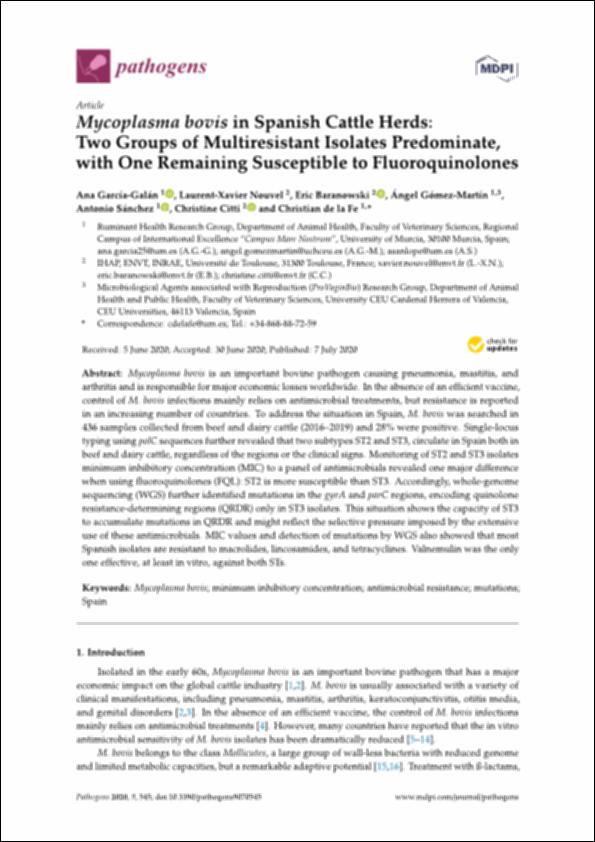Please use this identifier to cite or link to this item:
http://hdl.handle.net/10637/12740"Mycoplasma bovis" in Spanish cattle herds : two groups of multiresistant isolates predominate, with one remaining susceptible to fluoroquinolones
| Title: | "Mycoplasma bovis" in Spanish cattle herds : two groups of multiresistant isolates predominate, with one remaining susceptible to fluoroquinolones |
| Authors : | García Galán, Ana Nouvel, Laurent Xavier Baranowski, Eric Gómez Martín, Ángel Sánchez López, Antonio Citti, Christine Fe Rodríguez, Christian de la |
| Keywords: | Veterinary bacteriology.; Antibióticos en veterinaria.; Bacteriología veterinaria.; Bacterias - Resistencia a los medicamentos.; Antibiotics in veterinary medicine.; Micoplasmosis en los animales.; Mycoplasma diseases in animals.; Ganado vacuno - Enfermedades infecciosas.; Cattle - Communicable diseases.; Drug resistance in microorganisms. |
| Publisher: | MDPI. |
| Citation: | García-Galán, A., Nouvel, L.-X., Baranowski, E., Gómez-Martín, Á., Sánchez, A., Citti, C. et al. (2020). Mycoplasma bovis in Spanish cattle herds: two groups of multiresistant isolates predominate, with one remaining susceptible to fluoroquinolones. Pathogens, vol. 9, i. 7 (07 jul.), art. 545. DOI: https://doi.org/10.3390/pathogens9070545 |
| Abstract: | Mycoplasma bovis is an important bovine pathogen causing pneumonia, mastitis, and arthritis and is responsible for major economic losses worldwide. In the absence of an effcient vaccine, control of M. bovis infections mainly relies on antimicrobial treatments, but resistance is reported in an increasing number of countries. To address the situation in Spain, M. bovis was searched in 436 samples collected from beef and dairy cattle (2016–2019) and 28% were positive. Single-locus typing using polC sequences further revealed that two subtypes ST2 and ST3, circulate in Spain both in beef and dairy cattle, regardless of the regions or the clinical signs. Monitoring of ST2 and ST3 isolates minimum inhibitory concentration (MIC) to a panel of antimicrobials revealed one major difference when using fluoroquinolones (FQL): ST2 is more susceptible than ST3. Accordingly, whole-genome sequencing (WGS) further identified mutations in the gyrA and parC regions, encoding quinolone resistance-determining regions (QRDR) only in ST3 isolates. This situation shows the capacity of ST3 to accumulate mutations in QRDR and might reflect the selective pressure imposed by the extensive use of these antimicrobials. MIC values and detection of mutations by WGS also showed that most Spanish isolates are resistant to macrolides, lincosamides, and tetracyclines. Valnemulin was the only one effective, at least in vitro, against both STs. |
| Description: | Este artículo se encuentra disponible en la siguiente URL: https://www.mdpi.com/2076-0817/9/7/545 Este artículo pertenece al número especial "Mycoplasma bovis infections: occurrence, pathogenesis, diagnosis and control, including prevention and therapy". |
| URI: | http://hdl.handle.net/10637/12740 |
| Rights : | http://creativecommons.org/licenses/by/4.0/deed.es |
| ISSN: | 2076-0817 (Electrónico). |
| Issue Date: | 7-Jul-2020 |
| Center : | Universidad Cardenal Herrera-CEU |
| Appears in Collections: | Dpto. Producción y Sanidad Animal, Salud Pública Veterinaria y Ciencia y Tecnología de los Alimentos |
Items in DSpace are protected by copyright, with all rights reserved, unless otherwise indicated.


